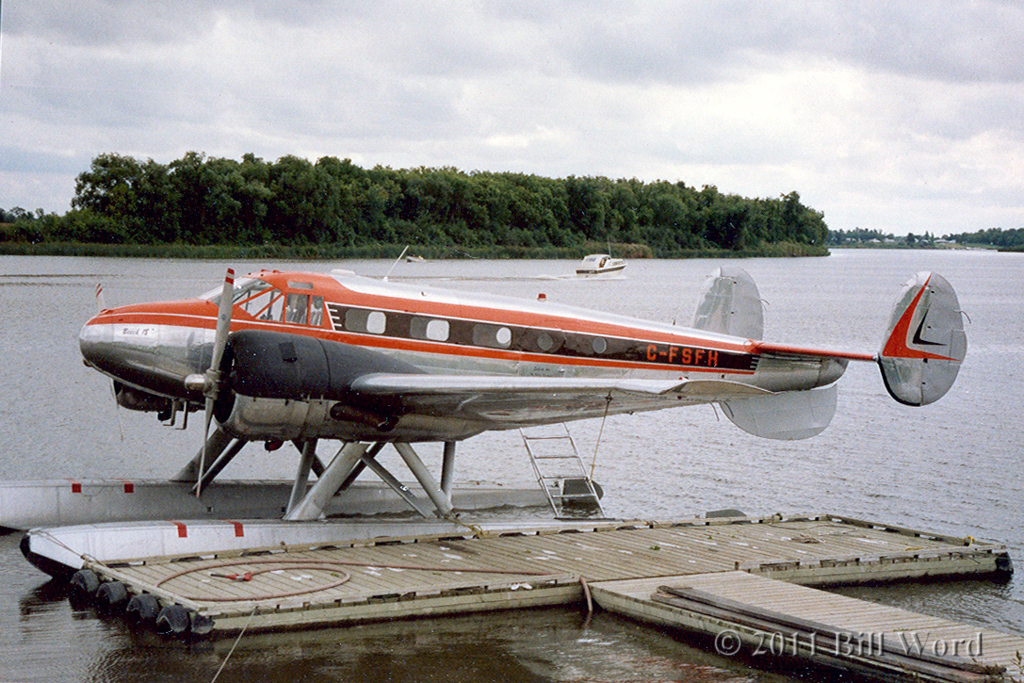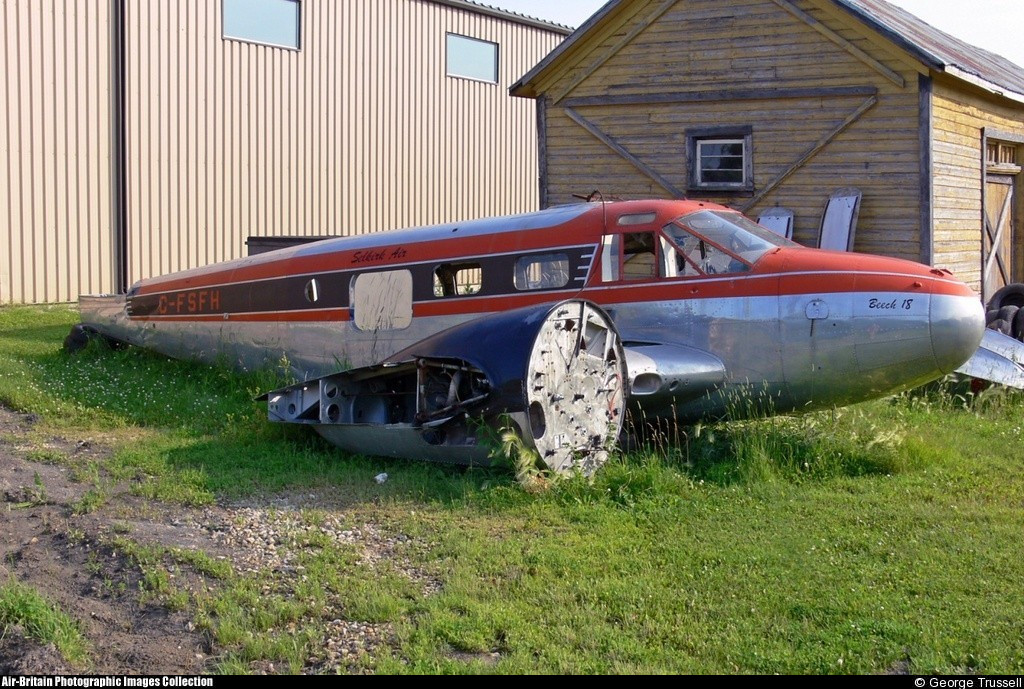Country
Crash of a Beechcraft C-45H Expeditor in Kodiak: 1 killed
Date & Time:
Jun 14, 2004 at 1137 LT
Registration:
N401CK
Survivors:
No
Schedule:
Anchorage – Kodiak
MSN:
AF-60
YOM:
1952
Crew on board:
1
Crew fatalities:
Pax on board:
0
Pax fatalities:
Other fatalities:
Total fatalities:
1
Circumstances:
The solo airline transport pilot departed on a commercial cargo flight in a twin-engine, turboprop airplane. As the flight approached the destination airport, visibility decreased below the 2 mile minimum required for the initiation of the approach. The pilot entered a holding pattern, and waited for the weather to improve. After holding for about 45 minutes, the ceiling and visibility had improved, and the flight was cleared for the ILS 25 instrument approach. After the pilot's initial contact with ATCT personnel, no further radio communications were received. When the flight did not reach the destination airport, it was reported overdue. A search in the area of an ELT signal located the accident airplane on a hilly, tree-covered island. A witness located to the north of the airport reported seeing a twin-engine turboprop airplane flying very low over the water, headed in an easterly direction, away from the airport. The witness added that the weather at the time consisted of very low clouds, fog, and rain, with zero-zero visibility. A local resident also stated that the weather conditions were often much lower over the water adjacent to the approach end of the airport than at the airport itself. The missed approach procedure for the ILS 25 approach is a climbing left turn to the south. About one minute after the accident, a special weather observation was reporting, in part: Wind, 060 degrees (true) at 11 knots; visibility, 2 statute miles in light rain and mist; clouds and sky condition, 500 feet broken, 900 feet broken, 1,500 feet overcast; temperature, 46 degrees F; dew point, 44 degrees F. According to FAA records, the company was not authorized to conduct single pilot IFR operations in the accident airplane, and that the accident pilot was the operator's chief pilot. Toxicology tests revealed cocaethylene and chlorpheniramine in the pilot's blood and urine.
Probable cause:
The pilot's failure to follow proper IFR procedures by not adhering to the published missed approach procedures, which resulted in an in-flight collision with tree-covered terrain. Factors contributing to the accident were a low ceiling, fog, rain, and the insufficient operating standards of company management by allowing unauthorized single pilot instrument flight operations. Additional factors were the pilot's impairment from cocaine, alcohol, and over the counter cold medication, and the FAA's inadequate medical certification of the pilot and follow-up of his known substance abuse problems.
Final Report:

Crash of a Beechcraft UC-45-J Expeditor in Swan Lake: 3 killed
Date & Time:
Sep 13, 2001 at 1735 LT
Registration:
N45N
Survivors:
No
Schedule:
Swan Lake – Mayo
MSN:
5715
YOM:
1943
Crew on board:
1
Crew fatalities:
Pax on board:
2
Pax fatalities:
Other fatalities:
Total fatalities:
3
Captain / Total hours on type:
200.00
Circumstances:
The privately owned and operated Beech UC45-J was flying out of an outfitter's camp located near Swan Lake, Yukon Territory. The aircraft departed the clay-and-gravel strip for Mayo with one pilot, two passengers, luggage, and a reported load of 800 pounds of moose and caribou meat. The aircraft accelerated down the runway in a normal fashion, with the tail becoming airborne first. The aircraft left the surface of the runway and began a steep climb, followed by a yaw and bank to the left. The aircraft entered the Pleasant Creek valley off the end of the runway in a near-vertical, nose-down attitude. An explosion occurred, followed by a plume of smoke. Two persons immediately attempted to rescue the pilot and the passengers but discovered the aircraft partly submerged in the creek and engulfed in flames from the post-crash fire. There were no survivors.
Probable cause:
Findings as to Causes and Contributing Factors:
1. The meat was loaded into the aircraft on a slippery surface and not adequately secured.
2. The manner in which the meat was loaded and secured most likely allowed the load to shift to the rear of the cabin during take-off. This rearward shift resulted in the loss of pitch control and an aerodynamic stall from which the pilot could not recover.
Other Findings:
1. The aircraft's C of G was most likely at or aft of the aft limit before engine start.
1. The meat was loaded into the aircraft on a slippery surface and not adequately secured.
2. The manner in which the meat was loaded and secured most likely allowed the load to shift to the rear of the cabin during take-off. This rearward shift resulted in the loss of pitch control and an aerodynamic stall from which the pilot could not recover.
Other Findings:
1. The aircraft's C of G was most likely at or aft of the aft limit before engine start.
Final Report:
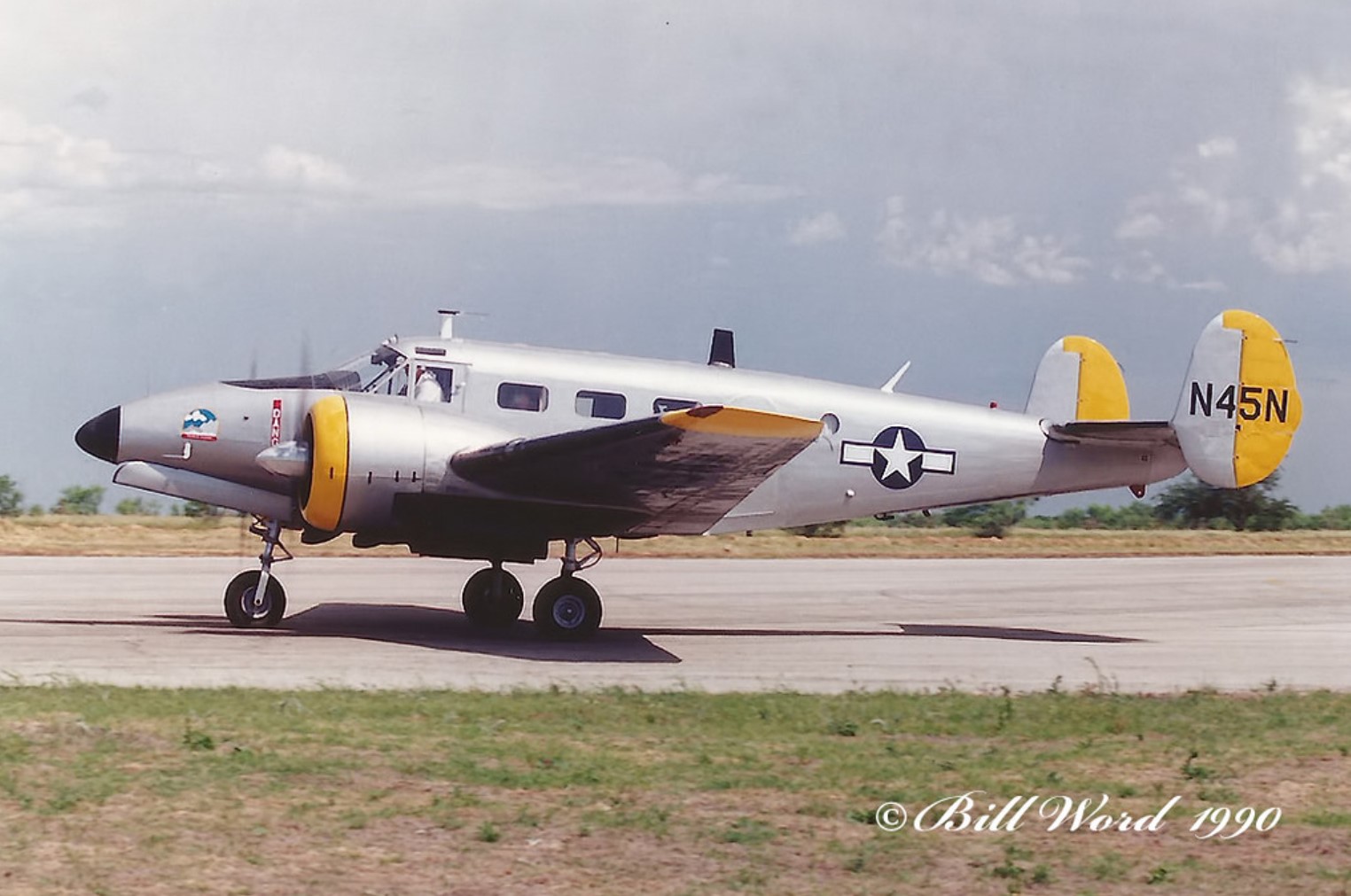
Crash of a Beechcraft C-45 Expeditor in Monroe
Date & Time:
May 14, 2000 at 1600 LT
Registration:
N6082
Survivors:
Yes
Schedule:
Pell City - Monroe
MSN:
5512
YOM:
1943
Crew on board:
1
Crew fatalities:
Pax on board:
0
Pax fatalities:
Other fatalities:
Total fatalities:
0
Captain / Total hours on type:
37.00
Circumstances:
The airplane bounced on landing and started to swerve on the landing roll. The pilot attempted a go-around. The left engine hesitated and the right engine developed power. The pilot lost directional control, the airplane went off the left side of the runway and collapsed the left main landing gear.
Probable cause:
The pilot's failure to maintain directional control during an attempted go-around, resulting in a loss of directional control, and subsequent collapse of the left main landing gear after the airplane departed the runway.
Final Report:
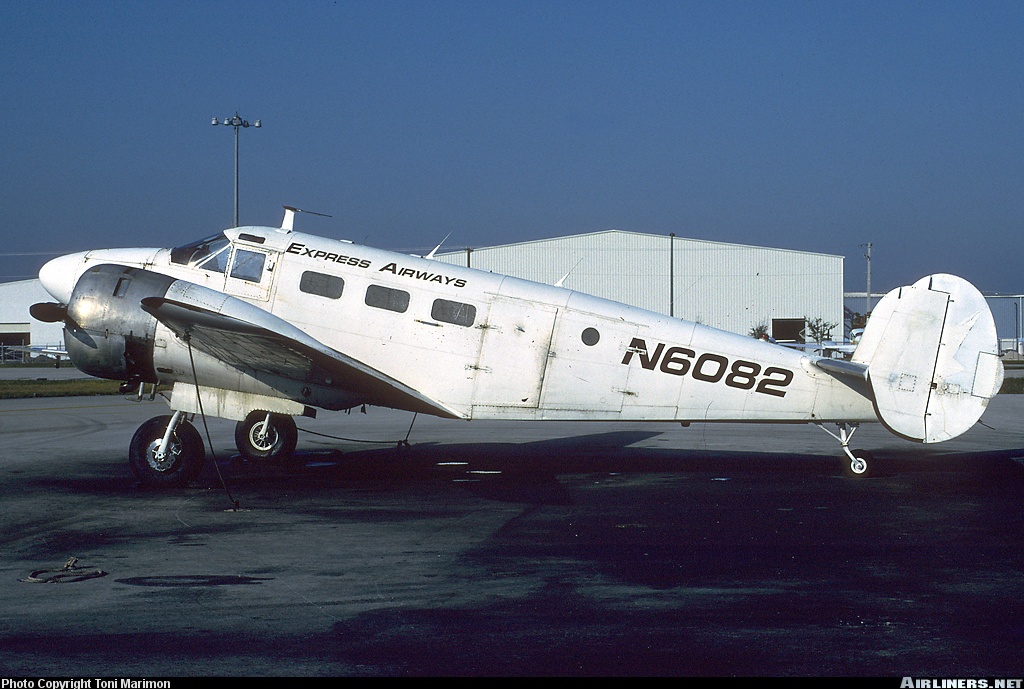
Crash of a Beechcraft UC-45J Expeditor in Urbana
Date & Time:
Apr 29, 2000 at 1315 LT
Registration:
N3482
Survivors:
Yes
Schedule:
Rantoul - Urbana
MSN:
7073
YOM:
1944
Crew on board:
1
Crew fatalities:
Pax on board:
2
Pax fatalities:
Other fatalities:
Total fatalities:
0
Captain / Total hours on type:
700.00
Circumstances:
The pilot said he performed three-point touchdown, landing to the east on a grass airstrip. He said, '... as we landed, the tail wanted to come up, so I pulled the stick all the way back and held
it back ... while I was reaching to lift the flaps off.' The pilot said that before he got the flaps retracted, he noticed the tail was coming up again. He ensured that the power was off and his feet were off the brakes. 'The airplane came up on its nose. We were almost stopped before we flipped on our back over the nose.' The pilot said that when he later returned to the airplane, he noticed the 'T-handle brake lever was 3/4 engaged.' Examination of the airplane revealed heavy longitudinally running grass rubbing on both tires. The brake discs were free and the wheels rotated freely. An examination of the field showed a pair of parallel-running tire marks moving toward the north side of the landing strip, and 11 succeeding slashes in the ground running perpendicular to the parallel tire tracks on the airplane's left side. An examination of the remaining airplane systems revealed no anomalies. Wind conditions, reported 14 minutes after the accident, were 010° at 7 knots.
it back ... while I was reaching to lift the flaps off.' The pilot said that before he got the flaps retracted, he noticed the tail was coming up again. He ensured that the power was off and his feet were off the brakes. 'The airplane came up on its nose. We were almost stopped before we flipped on our back over the nose.' The pilot said that when he later returned to the airplane, he noticed the 'T-handle brake lever was 3/4 engaged.' Examination of the airplane revealed heavy longitudinally running grass rubbing on both tires. The brake discs were free and the wheels rotated freely. An examination of the field showed a pair of parallel-running tire marks moving toward the north side of the landing strip, and 11 succeeding slashes in the ground running perpendicular to the parallel tire tracks on the airplane's left side. An examination of the remaining airplane systems revealed no anomalies. Wind conditions, reported 14 minutes after the accident, were 010° at 7 knots.
Probable cause:
The pilot not maintaining directional control on the ground and the abrupt brake application during the landing roll.
Final Report:
Crash of a Beechcraft C-45G Expeditor in Detroit: 1 killed
Date & Time:
Mar 11, 1999 at 0051 LT
Registration:
N234L
Survivors:
No
Schedule:
Detroit - Detroit
MSN:
AF-447
YOM:
1958
Crew on board:
1
Crew fatalities:
Pax on board:
0
Pax fatalities:
Other fatalities:
Total fatalities:
1
Aircraft flight hours:
7073
Circumstances:
The aircraft declared an emergency following departure from runway 03R at Detroit Metropolitan Wayne County Airport, Romulus, Michigan. The aircraft was resting on a magnetic heading of 055 degrees located approximately 3,400 feet from and 1,900 feet to the left of the departure end and centerline of runway 03R at DTW. Inspection of the forward section of the fuselage door and surrounding fuselage, a circular impression with no exposure of the underlying metal was noted approximately 2 feet 6-1/2 inches from the door hinge line. The door was opened to a point nearly flush with the aircraft's fuselage. The door handle was found to match the circular impression in position and shape. There was no tearing or fracturing of the forward fuselage door pin tips or its door pin holes. Inspection of the door's latching mechanism revealed a brown colored nail connecting the handle and vertical latches. Both engine supercharger turbine wheels displayed scoring and deformation of the impeller blades in the plane of rotation. Aileron, elevator and rudder flight control continuity was established. The elevator trim was in the neutral position. The trailing edge flaps were in the retracted positions. Both engine oil screens showed no evidence of metal contamination.
Probable cause:
The aircraft control not maintained and the inadvertent stall by the pilot while maneuvering to the landing area. The open door was a contributing factor.
Final Report:
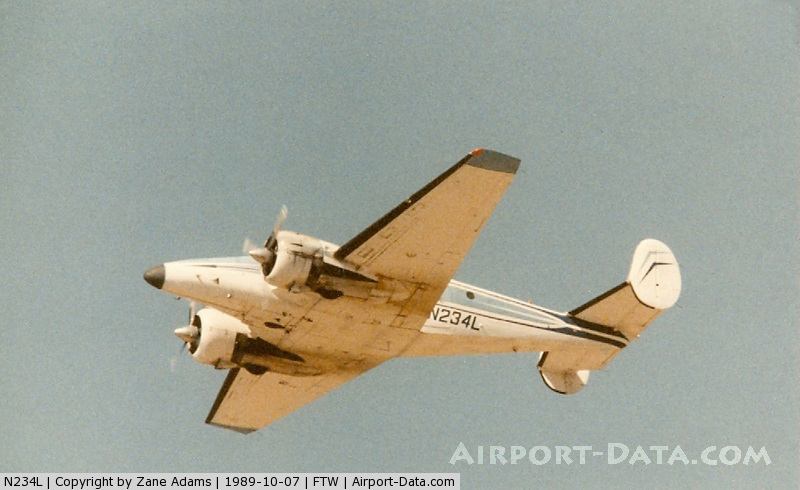
Crash of a Beechcraft UC-45J Expeditor in Miami
Date & Time:
May 2, 1996 at 1052 LT
Registration:
N64819
Survivors:
Yes
Schedule:
Miami - Fort Lauderdale
MSN:
5834
YOM:
1943
Crew on board:
1
Crew fatalities:
Pax on board:
0
Pax fatalities:
Other fatalities:
Total fatalities:
0
Captain / Total hours on type:
2245.00
Aircraft flight hours:
4254
Circumstances:
During departure, the rubber connector for the fuel supply line to the right engine oil dilution valve split at the dilution valve on the aft side of the firewall. The engine would not operate unless the electric boost pump was turned on. While returning to the departure airport, a fire erupted in the right wheel after the landing gear was extended. The cockpit filled with smoke during the landing rollout, and the pilot lost directional control do to not being able to see. The aircraft rolled into a canal and came to rest. The split rubber fuel line connector was dry and brittle and did not have any fire damage. No other sources of fuel leakage was found.
Probable cause:
Inadequate inspection of the fuel line connector by company maintenance personnel, and failure of a connector resulting in a fuel leak and fire.
Final Report:
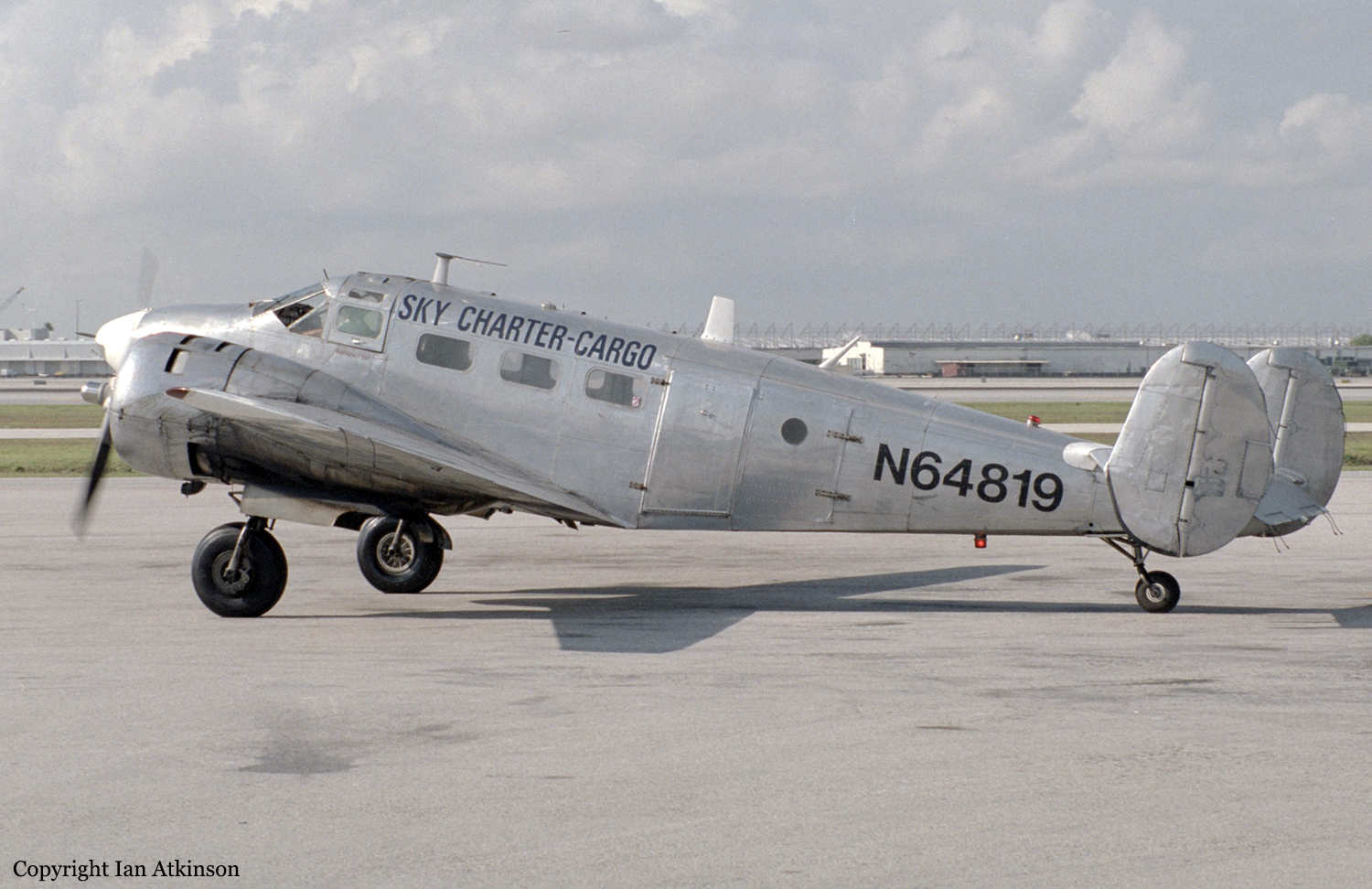
Crash of a Beechcraft C-45 Expeditor in Blountville
Date & Time:
Feb 2, 1996 at 1830 LT
Registration:
N204AA
Survivors:
Yes
Schedule:
Madison - Charlotte
MSN:
AF-79
YOM:
1954
Crew on board:
1
Crew fatalities:
Pax on board:
0
Pax fatalities:
Other fatalities:
Total fatalities:
0
Captain / Total hours on type:
350.00
Aircraft flight hours:
16972
Circumstances:
The pilot reported that as he overflew the Tri-City airport, Tennessee at 9,000 feet, the right engine power slowly decreased. The airplane was in the clouds with an outside air temperature of about zero degrees Celsius. Right engine manifold heat was applied for a few seconds, with no noticeable difference in engine performance. The right magnetos were also checked with no obvious malfunctions noted. A descent for landing was initiated to the Tri-City airport and manifold heat was applied and removed several times, with no appreciable effect. On short final approach, when the landing gear was extended, the right main gear did not indicate down. There was insufficient time to perform the emergency gear extension procedure. A go-around was initiated, during which the pilot discovered that the left manifold heat control was now stuck in the 'ON' position. The pilot stated that with less than full power available on the left engine, and the right propeller unfeathered, the airplane could be climbed to about 200 feet. He flew the airplane until terrain clearance was no longer possible, then landed in a field, gear up. The airplane slid into trees and was substantially damaged.
Probable cause:
The pilot's improper use of carburetor heat which resulted in a continuing loss of engine power, and the right landing gear's failure to extend during a single engine approach. A factor was the
insufficient time available to extend the landing gear via the emergency extension procedure.
insufficient time available to extend the landing gear via the emergency extension procedure.
Final Report:
Crash of a Beechcraft C-45 Expeditor in Bradburn lake
Date & Time:
Jun 5, 1995 at 1040 LT
Registration:
C-FSFH
Survivors:
Yes
Schedule:
Bradburn Lake - Selkirk
MSN:
5840
YOM:
1943
Crew on board:
1
Crew fatalities:
Pax on board:
6
Pax fatalities:
Other fatalities:
Total fatalities:
0
Captain / Total hours on type:
700.00
Aircraft flight hours:
15748
Circumstances:
The Beech 18 seaplane was departing a fishing camp at Bradburn Lake, Manitoba, for its third flight of the day en route to the operator's base at Selkirk. After boarding the passengers and loading the baggage for the flight, the pilot taxied the aircraft to a position near the southwest shore of the lake and started the take-off run on an approximate heading of 015° true. During the take-off run, after the aircraft was "on the step," the pilot noticed a yaw to the left. He corrected the yaw with the aircraft's rudders and with differential engine power. Shortly thereafter, at about 60 miles per hour (mph), the yaw recurred and worsened. The left float separated from the aircraft and the left wing struck the water. The aircraft turned sharply to the left, stopped in the water, and came to rest on its left wing tip in about 15 feet of water. The pilot and the six passengers were not injured; they exited the sinking aircraft and swam to shore. The accident occurred at 1040 central daylight saving time (CDT) during daylight hours at latitude 51°55'N and longitude 95°35'W.
Probable cause:
The left front swivel fitting attachment bolt probably moved out of position because the securing nut was either not installed or came off in service. A series of failures ensued, culminating in the separation of the left float from the aircraft.
Final Report:
